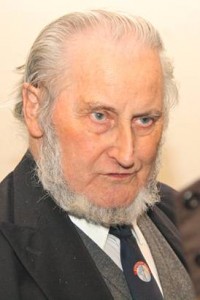March 7, 2011
Being an Astronomer at Greenwich in the 1950s
Gilbert Satterthwaite
Report by: Chris Sutcliffe & Mike Dryland
Gilbert is Chairman of the Society for the History of Astronomy (SHA), erstwhile leader of an MSc course at Imperial College, and famed for his work at Greenwich with Airy’s Transit Circle.
Gilbert began by explaining how he came to work as an astronomer. He became interested in the subject at the age of 11, and after studying mathematics and applied physics in the 6th form at Weymouth Grammar School in 1951, he went to an astronomy class at the college of higher education where he met Dr Arthur Alexander, Deputy Director of Education for Dorset.
Having received little encouragement from talking with his 6th form career adviser about a career in astronomy, he had some inspiration. He bought the book “Worlds without End” by Sir Harold Spencer Jones, Astronomer Royal, and sent the book to him requesting him to sign it. To his delight, he did sign it, and encouraged by this, Gilbert wrote to Sir Harold to enquire about job prospects in Astronomy. He received an information pack and an application form.
There were three possible career paths — a first-class maths degree from Cambridge – top; any degree – half way; A levels or other qualification – bottom of the ladder.
He was successful in getting an interview and saw Dr Atkinson and Mr Sims. The questions became progressively harder, but Mr Sims helpfully gave clues to answer the questions. He was offered a job!
Gilbert joined the Meridian Department and was trained up on the Airy Transit Circle — a big learning curve. Airy’s Transit Circle was used to make two measurements – the time at which a star crosses the meridian, as it appears to travel from East to West across the sky, and the angle of the star above the horizon. From these measurements an astronomer can calculate the star’s celestial coordinates – its precise position in the sky, relative to other stars. If the star’s coordinates are already known, then the transit of a star across the meridian could be used to check Greenwich Mean Time very precisely.
Gilbert worked a 5½ day week and had 6 weeks holiday.
Early on, he had a crash course in positional astronomy and Mr Sims was the best maths teacher he had ever had.
In addition to stars, Gilbert observed the Moon using the Airy Transit Circle, but the Moon’s motion is complex.
The last day of observations at Greenwich prior to moving to Herstmonceux was intended to be 31 March 1954, when the Chief Assistant planned to take the final ceremonial readings. But 31 March was a cloudy day, and so the last readings actually recorded were on 30 March when Gilbert had observed the Sun, Venus, Jupiter and Juno, with Pallas being the last observation. Gilbert thus gained the distinction of taking the last official readings with the Airy Transit Circle and has dined out on the story ever since!
In timing transits, the first astronomers at Greenwich had to listen to the beats of a sidereal clock. Airy designed his own chronograph, a rotating drum, with a pen which draws a line along as the drum turns, controlled by a clock with a rotating pendulum mechanism.
Gilbert recorded the observed time of a transit and the computed and observed time, and for each wrote the RA calculation.
His desk was always covered with books. The essential reference works were the Nautical Almanac, interpolation and associated tables, log tables, Barlow tables of squares, cubes and square roots etc
When the work of the Royal Greenwich Observatory moved to Herstmonceux, the 36-inch Yapp reflector (the largest telescope at Greenwich) moved with it and Gilbert saw it being silvered at Greenwich for the very last time. The 26-inch Thompson refractor, and also the Thompson 30-inch reflector which were housed in the South Building at Greenwich also moved to Herstmonceux. Interestingly, both Thompsons were mounted on the same support where they counterbalanced each other. However, at Herstmonceux, each was given its own mount.
On one occasion when no one from the Time Department was available, Gilbert raised the time ball on Flamsteed House at 12.55 pm (it falls automatically at 1.00 pm daily)
Gilbert moved to Herstmonceux in 1954 where he used its wonderful library. During the first few days, the Astronomer Royal walked in, and to Gilbert’s delight, greeted him by name. He was a very fine man and was on first name terms with every member of staff.
This was a fascinating lecture in which the history of the observatory at Greenwich truly came alive.
Some pictures from the evening [by Mike Dryland and Grey Lipley]:
Posted under: Flamsteed, Flamsteed Lecture, Meeting Report





















You must be logged in to post a comment.